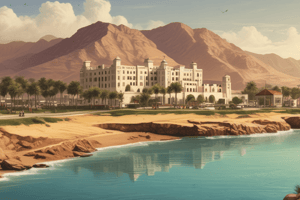Podcast
Questions and Answers
السهول الساحلية في عمان تشمل منطقة الباطنة على طول ساحل خليج عمان فقط.
السهول الساحلية في عمان تشمل منطقة الباطنة على طول ساحل خليج عمان فقط.
False (B)
الأمطار في عمان تكون خفيفة جدًا وتقل نسبيًا في المناطق الداخلية.
الأمطار في عمان تكون خفيفة جدًا وتقل نسبيًا في المناطق الداخلية.
True (A)
الزراعة في عمان تعتمد بشكل كبير على التقنيات الزراعية التقليدية.
الزراعة في عمان تعتمد بشكل كبير على التقنيات الزراعية التقليدية.
False (B)
التعليم في عُمان لا يُعتبر مهمًا ولا يتلقى الدعم اللازم.
التعليم في عُمان لا يُعتبر مهمًا ولا يتلقى الدعم اللازم.
أغلبية سكان عمان تتركز في المناطق الداخلية بالقرب من الواحات.
أغلبية سكان عمان تتركز في المناطق الداخلية بالقرب من الواحات.
Flashcards are hidden until you start studying
Study Notes
The Geography of Oman: From Rugged Mountains to Coastal Plans and Deserts
Located at the southwestern edge of the Arabian Peninsula, the Sultanate of Oman covers approximately 309,500 square kilometers of diverse landscapes and climatic conditions. With a coastline stretching nearly 3,165 km, Oman is bound by the United Arab Emirates in the northwest, Saudi Arabia in the west, Yemen in the southwest, and the Persian Gulf, Gulf of Oman, and Arabian Sea to the northeast and southeast respectively.
Physical Geography
Mountainous Regions
One of the primary physiographic features in Oman is the Al-Hajar Mountains, a stretch of high, rugged terrain that runs along the Gulf of Oman from the Musandam Peninsula to Ra's Al-Hadd, the easternmost tip of the Arabian Peninsula. Peaks within the Al-Hajar Mountains often exceed 4,800 feet (1,463 meters), with the highest elevation recorded at Al-Jabal Al-Akhdar, surpassing 10,000 feet (3,000 meters).
Central Divide and Interior Deserts
The great central divide of Wadi Sama'il separates the Al-Hajar Mountains into two main sections: a western range and an eastern range. To the southwest of the Al-Hajar Mountains lies the vast Rub' al-Khali (Empty Quarter) desert, shared with Saudi Arabia and Yemen.
Coastal Plains and Alluvial Soils
Throughout Oman, you'll find various unofficial geographical regions, including the long, narrow coastal plain of Al-Batinah along the Gulf of Oman, the wooded mountain ranges, and the fertile alluvial soils of the Dhofar (Zufar) region's coastal plain.
Climate and Rainfall Patterns
The climate across Oman is generally arid and semi-arid, although there are notable differences among different regions. Northern and central regions experience mild winters with occasional rainfall from November through April, while southern regions, particularly Dhofar, are subject to a seasonal summer monsoon from June to September. Average annual rainfall ranges from less than 20 mm in the internal desert regions to over 300 mm in the mountain areas.
Agriculture and Natural Resources
Oman's agricultural lands encompass five distinct regions that extend from the north to the south of the country. These regions consist of the Musandam Peninsula, the Batinah coast, the interior oases, and the Dhofar region. Agricultural practices in Oman are predominantly market-oriented, utilizing new farming technologies and water-saving irrigation systems.
Population and Settlement Patterns
Despite the diverse geography and climate conditions, the Sultanate of Oman has a relatively low population density. The country's majority population is concentrated in the northern coastal plain of Al-Batinah, along the Gulf of Oman, and in the capital city of Muscat. Smaller settlements can be found in the interior regions, near oases, and in the southern coastal region of Dhofar.
Education and Geography Curriculum
The importance of geography education in Oman is evident through research such as "The State of Geography in Basic Education Schools in Muscat, Oman," which examines teachers' preferences for teaching topics and methods, as well as the challenges faced by educators in teaching geography.
In summary, the geography of Oman is characterized by its rugged mountain ranges, vast deserts, and coastal plains. Understanding these geographic features is crucial for the country's sustainable development, resource management, and long-term environmental planning.
Studying That Suits You
Use AI to generate personalized quizzes and flashcards to suit your learning preferences.




